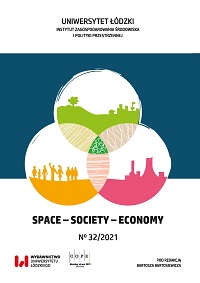The local plan of revitalization as a spatial policy tool for the historical town center
DOI:
https://doi.org/10.18778/1733-3180.32.07Keywords:
local plan of revitalization, local spatial development plan, revitalization, urban planning, townAbstract
Intentional spatial policy at the commune level is one of the basic determinants of socio-economic development. Errors or omissions in this regard may cause social tensions, economic, ecological and demographic crises, and other dysfunctions. They can also significantly contribute to the degradation of the cultural landscape and the disappearance of local architectural and urban features. This is especially important in the case of small and medium-sized towns. The Revitalization Act introduced a new tool for the implementation of spatial policy assumptions, i.e. the local plan of revitalization.
The aim of this article is to assess the potential effectiveness of a local plan of revitalization. The author’ attention is focused on functional, spatial and architectural issues. The article discusses the possibilities offered by the Revitalization Act in relation to the development of the functional and spatial structure of the town and the quality of architectural transformations. The potentials and limitations of these solutions have been highlighted. The subject of the study are planning arrangements and their potential spatial effects, especially in relation to small towns. The conclusions presented in the article are the result of the analysis of legal acts and the experiences of the conceptual case study of Wieluń town. The analysis is critical and relates directly to the potential effectiveness of revitalization plans in shaping the spatial policy, especially the renewal and activation of the areas of historic town centers.
The study of the possibility of using the Act is an important element in the search for an appropriate methodology for the preparation of local revitalization plans. The knowledge of the dependencies between planning instruments and the practical effects of their application gives a chance for an in-depth verification of the developed draft plans. Thus, it should contribute to the improvement of their effectiveness in shaping the spatial policy. Considerations regarding local revitalization plans are an important element of the discussion on possible interference in the existing planning order.
The conducted research shows that the local revitalization plan can be an effective tool supporting the processes of renewal and activation of historic central areas of small towns. This is due to the expansion of the commune’s competences in the field of shaping the urban and architectural form of the town. It should be recognized that it is a document that supports the protection of the cultural landscape and allows for the shaping of the city landscape in a conscious and consistent manner. It can also contribute to the social and economic revitalization of historic town centers. Its use, however, requires significant competences at the design and administrative level. The authors also point to the imperfection of many solutions introduced by the act, e.g. restrictions in the use of the so-called urban contract. They emphasize that the procedure of developing the document is complicated and its application is limited only to designated areas of revitalization. In particular, they note the high impact of the revitalization plan on property rights. This carries the risk of non-acceptance by residents / investors. It also raises the costs of compensation. In this context, especially in the case of small and medium-sized towns with limited budgets, real implementation of the solutions offered by the local revitalization plan may prove impossible due to financial implications.
Downloads
References
Bal-Domańska B., 2020, Badania rewitalizacji na poziomie gmin, „Samorząd Terytorialny”, 7–8: 95–108.
Google Scholar
Bieda A., 2017, Urban renewal and the value of real properties, „Studia Regionalne i Lokalne”, 3(69): 5–28.
Google Scholar
Brzezińska-Rawa A., Sylwestrzak D., 2021, Prawne podstawy działania gmin za pomocą instrumentów planistycznych w zakresie migracji, „Samorząd Terytorialny”, 9: 65–76.
Google Scholar
Burmeister T., 2003, Der städtebauliche Vertrag als rechtliches Instrument der Kooperation mit Privaten bei der Baulandentwicklung und erschließung, Dissertation, Technische Universität Berlin, Berlin. http://dx.doi.org/10.14279/depositonce-715
Google Scholar
Cieślak A., 2018, Miejscowy plan zagospodarowania przestrzennego jako narzędzie kształtowania krajobrazu małego miasta. Wybrane zagadnienia, „Przestrzeń i Forma”, 35: 177–206. https://doi.org/10.21005/pif.2018.35.D-01
Google Scholar
DOI: https://doi.org/10.21005/pif.2018.35.D-01
Czekiel-Świtalska E., Świtalska A., 2017, Planowanie czy zagospodarowanie przestrzenne, „Teka Komisji Urbanistyki i Architektury O/PAN w Krakowie”, 45: 309–317.
Google Scholar
Franta A., 2004, Reżyseria przestrzeni: o doskonaleniu przestrzeni publicznej miasta, Monografia, Wydawnictwo Politechniki Krakowskiej, Kraków.
Google Scholar
Glasson J., Wood G., 2009, Urban regeneration and impact assessment for social sustainability, „Impact Assessment and Project Appraisal”, 27(4): 283–290. https://doi.org/10.3152/146155109X480358
Google Scholar
DOI: https://doi.org/10.3152/146155109X480358
Jackson C., 2018, The effect of urban renewal on fragmented social and political engagement in urban environments, „Journal of Urban Affairs”, 41(4): 503–517. https://doi.org/10.1080/07352166.2018.1478225
Google Scholar
DOI: https://doi.org/10.1080/07352166.2018.1478225
Jopek D., 2018, Czynniki kształtujące przestrzenną formę miasta, „Rozwój Regionalny i Polityka Regionalna”, 42: 81–89.
Google Scholar
Kosiński W., 2000, Aktywizacja turystyczna małych miast. Aspekty architektoniczno-krajobrazowe, Monografia 269, Wydawnictwo Politechniki Krakowskiej, Kraków.
Google Scholar
Legutko-Kobus P., Nowak M.J., 2020, Niesprawność władz publicznych w świetle prawno-przestrzennych i partycypacyjnych narzędzi rewitalizacji, „Studia z Polityki Publicznej”, 7(3(270)): 117–135. https://doi.org/10.33119/KSzPP/2020.3.7
Google Scholar
DOI: https://doi.org/10.33119/KSzPP/2020.3.7
Marx S.P., 2003, Europäisches Planungsrecht und Public Private Partnerships im Städtebau, Buch, Universität Kassel, Kassel. https://kobra.uni-kassel.de/handle/123456789/2006102315190?show=full
Google Scholar
Masztalski R., 2014, Miejsce handlu we współczesnej przestrzeni małego miasta Polski, [w:] Masztalski R. (red.), Współczesne funkcje handlowe w wybranych małych miastach województwa dolnośląskiego, Oficyna Wydawnicza Politechniki Wrocławskiej, Wrocław: 9–20.
Google Scholar
Maurer H., Waldhoff Ch., 2020, Allgemeines Verwaltungsrecht, Buch, C.H. Beck, ISBN online: 978-3-406-75897-3. https://doi.org/10.17104/9783406758973
Google Scholar
DOI: https://doi.org/10.17104/9783406758973
Mehdipanah R., Marra G., Melis G., Gelormino E., 2017, Urban renewal, gentrification and health equity: a realist perspective, „European Journal of Public Health”, 28(2): 243–248. http://doi.org/10.1093/eurpub/ckx202
Google Scholar
DOI: https://doi.org/10.1093/eurpub/ckx202
Mikuła Ł., 2017, Nowe instrumenty ekonomiczne polityki miejskiej w świetle ustawy o rewitalizacji, „Rozwój Regionalny i Polityka Regionalna”, 39(1): 47–60.
Google Scholar
Nelicki A., Zachariasz I., 2008, Planowanie przestrzenne a udział podmiotów prywatnych w budowie infrastruktury publicznej. Rozwiązania polskie a wybranych krajów UE i USA, „Samorząd Terytorialny”, 10: 29–41.
Google Scholar
Nowak M.J., 2015, Nieefektywność decyzji o warunkach zabudowy i zagospodarowania terenu w kształtowaniu ładu przestrzennego, a działania administracji publicznej, „Biuletyn PAN Komitet Przestrzennego Zagospodarowania Kraju”, 257–258: 46–57.
Google Scholar
Nowak M.J., 2019, Miejscowy plan rewitalizacji – szczególna forma miejscowego planu zagospodarowania przestrzennego (komentarz praktyczny), „LEX/el.” (dostęp: 18.12.2021).
Google Scholar
Nowakowski M., Bańkowska B., 2013, Sto lat planowania przestrzeni polskich miast (1910–2010), Oficyna Naukowa, Warszawa.
Google Scholar
Purzyński R., 2021, A maximis ad minima. Rewitalizacja małego miasta na przykładzie Wielunia, praca dyplomowa – magisterska, Instytut Architektury i Urbanistyki Politechniki Łódzkiej, Łódź, promotor: dr inż. arch. Adriana Cieślak-Arkuszewska (materiał niepublikowany).
Google Scholar
Raport o stanie polskich miast. Rewitalizacja, 2019, Jarczewski W., Kułaczkowska A. (red.), Obserwatorium Polityki Miejskiej Instytutu IRMiR, Warszawa–Kraków.
Google Scholar
Rewitalizacja w praktyce. Modele rozwiązań jako rezultaty konkursu Modelowa Rewitalizacja Miast i pilotaży w zakresie rewitalizacji, 2018, Jadach-Sepioło A., Kułaczkowska A., Mróza A. (red.), Krajowy Instytut Polityki Przestrzennej i Mieszkalnictwa, Warszawa.
Google Scholar
Rewitalizacja zdegradowanych obszarów miast, 2016, Departament Infrastruktury, Najwyższa Izba Kontroli, Informacja o wynikach kontroli, Warszawa.
Google Scholar
Ruczkowski P., 2020, Umowa urbanistyczna w procesie rewitalizacji – charakter prawny i konsekwencje prawne jej zawarcia, „Annales Universitatis Mariae Curie-Skłodowska. Sectio G. Ius”, 67(1): 85–97.
Google Scholar
DOI: https://doi.org/10.17951/g.2020.67.1.85-97
Skalski K., 2018, Dziedzictwo kulturowe małych miast jako wektor rozwoju gospodarczego w programach rewitalizacji, „Przestrzeń i Forma”, 34: 247–264. http://doi.org/10.21005/pif.2018.34.C-09
Google Scholar
DOI: https://doi.org/10.21005/pif.2018.34.C-09
Sobol A., 2005, Małe miasta w teorii i praktyce zrównoważonego rozwoju, [w:] Heffner K. (red.), Małe miasta a rozwój lokalny i regionalny, Katowice: 43–52.
Google Scholar
Szlachetko J.H., 2017, Miejscowy plan rewitalizacji a miejscowy plan zagospodarowania przestrzennego. Różnice w zakresie przedmiotowym upoważnienia ustawowego, „Metropolitan. Przegląd Naukowy”, 1(7): 40–59.
Google Scholar
Szlachetko J.H., Szlachetko K., 2019, Udział interesariuszy w kształtowaniu i prowadzeniu polityki rewitalizacyjnej, Wydawnictwo Uniwersytetu Gdańskiego, Gdańsk.
Google Scholar
Twardzik M., 2016, Oddziaływanie galerii handlowych na śródmiejskie ulice handlowe Katowic, „Acta Universitatis Lodziensis. Folia Geographica Socio-Oeconomica”, 23(1): 67–85.
Google Scholar
DOI: https://doi.org/10.18778/1508-1117.23.04
Ustawa krajobrazowa, rewitalizacyjna i metropolitalna. Komentarz do przepisów o planowaniu i zagospodarowaniu przestrzennym, 2016, Nowak M., Tokarzewska-Żarna Z. (red.), C.H. Beck, Warszawa.
Google Scholar
Ustawa o planowaniu i zagospodarowaniu przestrzennym. Komentarz, 2016, Wierzbowski M., Plucińska-Filipowicz A. (red.), Wolters Kluwer, Warszawa.
Google Scholar
Wdowicka M., Mierzejewska L., 2012, Chaos w zagospodarowaniu przestrzennym stref podmiejskich jako efekt braku zintegrowanego systemu planowania (na przykładzie strefy podmiejskiej Poznania), „Problemy Rozwoju Miast”, 1: 40–52.
Google Scholar
Wiśniewski J., 2017, Program rewitalizacji w rozwoju miast. Przykład Lidzbarka Warmińskiego, [w:] Strzelecka E. (red.), Alternatywne modele rozwoju miast. Sieć miast Cittaslow, Politechnika Łódzka, Łódź: 240–250.
Google Scholar
Wojnarowska A., 2016, Inwestycje mieszkaniowe w ramach programów rewitalizacji centrum Łodzi, „Space–Society–Economy”, 15: 69–88. https://doi.org/10.18778/1733–3180.15.06
Google Scholar
DOI: https://doi.org/10.18778/1733-3180.15.06
Zagroba M., 2016, Problems of the Revitalization of Historic Centres in Small Towns in the North-Eastern Poland, „Gazi University Journal of Science”, 4: 723–729.
Google Scholar
Złakowski Ł., 2018, Komentarz do art. 37i, [w:] Niewiadomski Z. (red.), Planowanie i zagospodarowanie przestrzenne. Komentarz, Warszawa: 363.
Google Scholar
Ustawa z dnia 20 czerwca 1997 r. Prawo o ruchu drogowym (Dz.U. z 2021 r., poz. 450 z późn. zm.).
Google Scholar
Ustawa z dnia 27 marca 2003 r. o planowaniu i zagospodarowaniu przestrzennym (Dz.U. z 2021 r., poz. 741 z późn. zm.).
Google Scholar
Ustawa z dnia 9 października 2015 r. o rewitalizacji (Dz.U. z 2021 r., poz. 485).
Google Scholar
Rozporządzenie Ministra Infrastruktury i Budownictwa z dnia 1 lipca 2016 r. w sprawie zakresu projektu miejscowego planu rewitalizacji w części tekstowej oraz zakresu i formy wizualizacji ustaleń miejscowego planu rewitalizacji (Dz.U. z 2016 r., poz. 1032).
Google Scholar
Rozporządzenie Ministra Transportu i Gospodarki Morskiej w sprawie warunków technicznych, jakim powinny odpowiadać drogi publiczne i ich usytuowanie z dnia 2 marca 1999 r. (Dz.U. z 2016 r., poz. 124 z późn. zm.)
Google Scholar
Downloads
Published
How to Cite
Issue
Section
License

This work is licensed under a Creative Commons Attribution-NonCommercial-NoDerivatives 4.0 International License.









